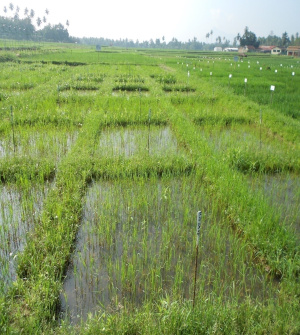
- Address : Bathalagoda, Ibbagamuwa, Sri Lanka
- E- Mail : rrdi@doa.gov.lk
- Telephone : +94 372 258561
- Fax : +94 372 259881
TECHNOLOGIES
Agronomy Division - Modified water seeding method for weed management in rice
Some rice varieties have an ability to germinate in water logged condition and therefore, can tolerate flooding during germination and seedling growth. This ability is known as anaerobic germination tolerance (AG-tolerance). If AG-tolerance is used in direct-seeded rice (DSR), it can be used to minimize the weed growth and thus reducing the herbicide usage. Also, rodent and bird damages to sown seeds can be minimized by maintaining standing water in the field. Further, the rice seeds or seedlings can withstand early flooding without much damage, and thus re-establishment will not be required especially in the WZ. This is a modified water seeding method and can be considered as an environmentally-friendly and economically-feasible technique in rice cultivation in Sri Lanka. The success of this technique is depend on selecting suitable varieties and adapting better agronomic management practices.
The NIVs; Bg 300, At 308, Bg 310, Bw 351, Bw 367, Bg 366, Bg 380 and Bg 379-2 are suitable for modified water seeding method. The three-month age class rice variety Bg 300, which is one of the widely grown rice variety in Sri Lanka, is one of the most suitable variety. Though these varieties are found to be moderately AG-tolerant, they can produce comparative population density and grain yield with flooding when all other conditions (good quality seeds, appropriate seed bed preparation, suitable seeding rate and shallow flooding height) are fulfilled. Certified seed paddy having germination >85% when sowing should be used. They should be freshly harvested robust with no breakage, discoloration, unfilled or half-filled. The seeds harvested in the previous season could be effective if stored properly in a well-ventilated place with recommended temperature (25 °C) and Rh (60-70%) conditions. In water seeded rice, seeds are soaked in water for 24-36 h and sprouted for 24-36 h before sowing. However, for the modified method, seeds soaked in water for 24 h and incubated for 48 h as in wet-DSR can be used.
A seeding rate of 100 kg ha-1 which is the seed paddy requirement recommended by the DOA for intermediate bold type in wet-DSR is suitable for flooded-DSR. Field preparation should be done as recommended by the DOA. Field should be properly levelled to maintain a shallow water height of 2-2.5 cm at sowing. This water level should be kept at the same level up to 7-10 days after sowing (DAS) to obtain a higher crop stand and lower weed growth. The flooding height can be then maintained at 4- 5 cm as in irrigated condition. In water-seeded rice, a rough seed bed with large clods is recommended to allow the seeds to settle without being subjected to drift. In flooded-DSR, this can be practiced, but if the flood water is stirred just before seeding to settle down the seeds on soil surface with a thin layer of mud without subjected to drifting.
Herbicide application for weed control is not required in modified water seeding method as it minimizes the grasses and sedges commonly found in the rice fields. However, if aquatic weeds are present, application of a suitable herbicide at 2-3 weeks after sowing (WAS) is recommended. Fertilizer application, insect pest and disease control and other management practices should be done as recommended by the DOA. Sowing should be avoided during heavy rains and cloudy periods and during times when water temperature is higher than 28 oC.


